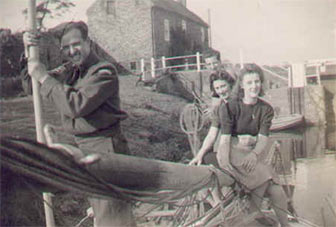Linton
Lock was built by the well known civil engineer, John Smeaton in 1767 under powers
granted by an act of 1767 to provide a navigable link between Ripon, York and
the Humber Estuary. Since that time the navigation and the lock have been owned
and managed by the Linton Lock Commissioners. The navigation was constructed
to carry agricultural products from the Vale of York to the Hmber Estuary and
was very successful for many years. Since the turn of the Century the level of
traffic has steadily declined to the extent that toll income became non-existent.
In order to maintain income the Commissioners obtained powers to charge for pleasure
boats using the lock and since the 1950's they have fought to keep the lock open
to give access up and down the river.  In
1937 the Royal Air Force became residents of Linton-on-Ouse with the opening of
a base in the village (RAF Linton-on-Ouse). In
1937 the Royal Air Force became residents of Linton-on-Ouse with the opening of
a base in the village (RAF Linton-on-Ouse).
In the late 1980's major engineering
problems developed with the lock island requiring significant stabilisation works
costing £1 million to ensure the long term security of the lock, lock island
and cottage. The Heritage Lottery Fund supported the project with a grant of over
£700,000. Additional funds were provided by Local Authorities, The Environment
Agency, British Waterways, voluntary organisations and individuals. Major engineering
works were successfully undertaken in 1998 to stabilise the lock island, repair
the lock and rebuild the lock cottage. To ensure the long term security of the
lock complex, and to integrate it into the national waterway network, the lock
and lock island has been transferred to British Waterways from the Linton Lock
Commissioners. The Lock Cottage and moorings are privately owned. |